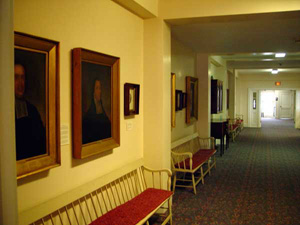

| No, it's not an Edgar Allan Poe tale, or an Erle Stanley Gardner mystery. It's all about the large rooster that sits high above town, perched atop the steeple of the First Church. Standing a full four feet high, constructed of copper and covered in gold leaf with green glass eyes, this proud bird was either imported or sent from England sometime before 1800. No one is really sure when the weathervane was constructed; or if it is, in fact, a weathervane. There are no compass points or any other devices to indicate wind direction. Records of it first appear in the accounts of the Great Gale of 1821, which toppled the steeple. There is talk of a conflagration which destroyed some town records pertinent to the date of its appearance. |
 |
|
The riddle to me doesn't center on "when" so much as "why". At first blush, one would expect a cross to adorn the top of a church, or perhaps a globe or simple spire. The idea of a golden rooster on a house of worship almost seems blasphemous. Certainly a dog, cat or golden calf would have precipitated much heated debate, evoking the imagery of Pagan idolatry. And yet, there he sits. At the very highest point in the entire town, our chanticleer captures the first rays of the rising sun. A blazing yellow in the morning sun, he draws one westward almost like a lodestone. As the day draws to a close, he changes to a softer mellow hue as the setting sun sets his green eyes ablaze. There is definitely something entirely extraordinary about this beast. And beast he is, just as we. Perhaps that is the key to the riddle. One may think that a common rooster would belong atop a barn, rather than a church. But perhaps there is a Lesson from the old Transcendentalists here as well. Our noble chanticleer arises again and again to herald the start of a new day…a new possibility; perhaps even the start of a new and proud young country! Inside the barn are the mangers, which are no more than feeding troughs. Indeed the word comes from the Italian "mangia"…to eat. Just as the common beasts derive both shelter and sustenance in their barn, so do we in our "barns". We regularly gather together, beneath the watchful eye of our chanticleer, to perpetuate and rekindle a social bond, reaffirm obligations, and also to derive sustenance from the Words of the Shepherd. Two centuries ago, in an agrarian society, our golden bird, almost as the Phoenix, may have been meant to symbolize the continuity in all life forms and our mutual interdependence….a reminder that all life is precious and must be appreciated. Then again, maybe it's just a big old rooster. I paid a visit to the First Church this past week, and my town history "mini-series" immediately went from black-and-white to blazing Technicolor. What started out centuries ago as a small rude building with benches and no heat has succeeded in evolving into the closest thing we have to a town museum. |
 |
|
From the gallery of portraits of Pastors, the priceless photographs, handmade musical instruments, Paul Revere's bell, to countless historic icons and bequests, the First Church is a virtual treasure trove.  |
 |
|
In my prior articles, I had covered a portion of its beginnings. At this point, I am going to defer to the First Church to tell the rest of its own story, in its own words. You can find it at www.firstchurchlongmeadow.org It may seem that an extraordinary amount of history has been centered on the First Church. There is a reason for that. Before it was the church, it was the meeting-house. From the very start of a small community of less than forty families, it was the focal point of social as well as religious life. There was absolutely no division between church and state. All aspects of life revolved around it, or at least passed through it. This entity served as not only moral compass, but the very glue which held society together in times of war, natural disaster, as well as in times of peace. |
|
I would like to thank Program Director Gay Wesson and Assistant Sexton Angel Cintron for their generosity of spirit and invaluable assistance! A response and interesting interpretation of the rooster was offered by Mr. Stephen Warnock, of Longmeadow, who states "The rooster is a very important part of Christian iconology. In Matthew 24:34 Christ tells Peter that before the rooster crows, 'you will deny me three times'. In the following verses, Peter refuses to believe what he was told but, after Christ was arrested someone asked Peter if he knew Christ and Peter denied knowing Him upon which a rooster crowed". Interestingly enough, Mr. Warnock adds that in England a rooster sat atop most churches as a reminder to the people not to deny Christ. Thanks for your input! Our golden chanticleer is also found on the Town Seal, along with a beaver.  |